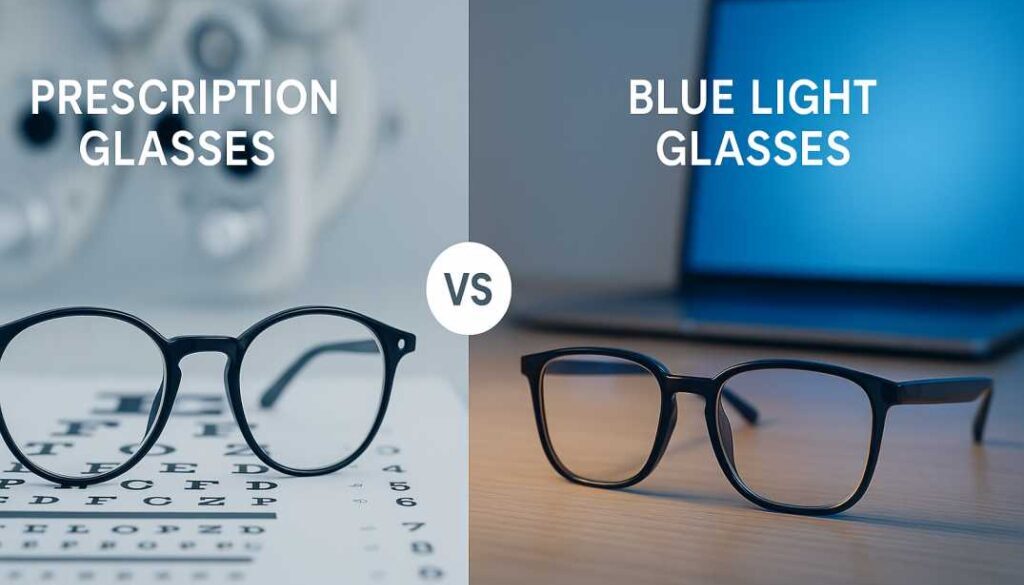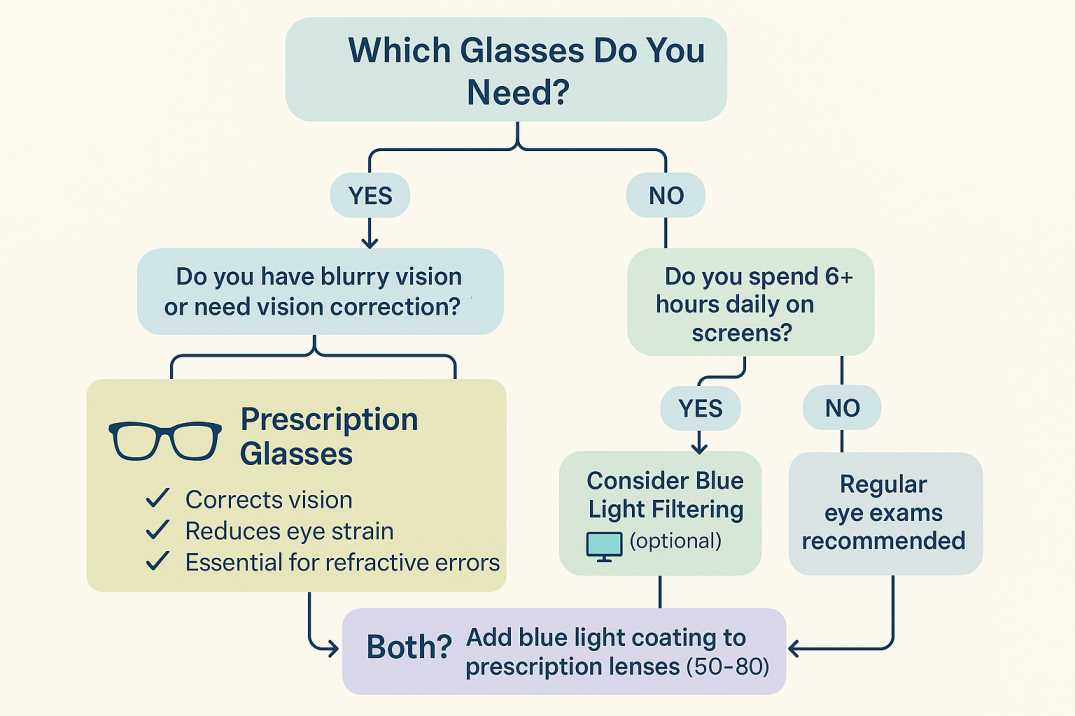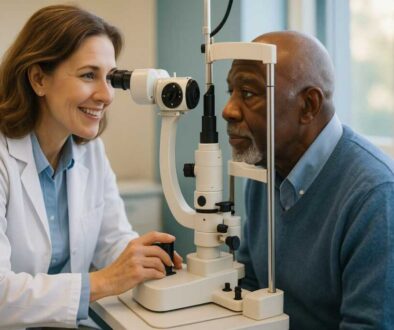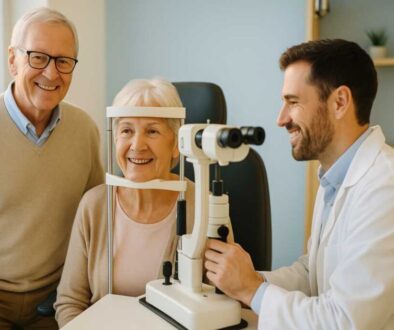Prescription Glasses vs Blue Light Glasses: 2025 Guide
Introduction: The Great Glasses Debate
If you’re spending hours in front of screens and wondering whether you need prescription glasses, blue light glasses, or both, you’re not alone. With so much conflicting information online, it’s easy to feel confused about what your eyes actually need.
Here’s the bottom line upfront: Prescription glasses correct vision problems like nearsightedness, farsightedness, and astigmatism, while blue light glasses filter specific wavelengths of light from digital screens. They serve completely different purposes, and understanding which one (or both) you need depends on your unique eye health needs.
At Poudre Valley Eyecare, we’ve been helping Fort Collins families navigate these decisions for over 25 years. In this guide, we’ll cut through the marketing hype and give you the facts you need to make an informed choice about your eye health.
Understanding Prescription Glasses: The Vision Correction Solution
What Are Prescription Glasses?
Prescription glasses are medical devices designed to correct refractive errors in your eyes. When your cornea or lens doesn’t bend light correctly, images become blurry and out of focus. Prescription lenses compensate for these errors by adjusting how light enters your eye before it reaches your retina.
How Prescription Glasses Work
Your eyes work like cameras, focusing light onto the retina at the back of your eye. When you have a refractive error, light doesn’t focus properly, causing:
- Myopia (nearsightedness): Difficulty seeing distant objects clearly
- Hyperopia (farsightedness): Trouble focusing on nearby objects
- Astigmatism: Blurred vision at all distances due to an irregularly shaped cornea
- Presbyopia: Age-related difficulty focusing on close-up tasks
Prescription lenses bend light in precisely calculated ways to ensure it focuses correctly on your retina, giving you clear, sharp vision.
The Benefits of Prescription Glasses
According to the Vision Council’s latest 2025 research, 83 percent of U.S. adults use some form of vision correction—including glasses, prescription sunglasses, reading glasses, and contact lenses—with 68 percent specifically using prescription eyewear. Here’s why prescription glasses remain the gold standard:
Clear Vision and Reduced Eye Strain
When you wear the correct prescription, you can see clearly without squinting or straining. This reduces headaches, eye fatigue, and discomfort that come from forcing your eyes to work harder than they should.
Improved Quality of Life
From reading road signs to working on your computer, proper vision correction impacts every aspect of daily life. Students perform better academically, professionals work more efficiently, and seniors maintain independence longer with the right prescription.
Protection and Prevention
Many prescription glasses now include UV protection, scratch-resistant coatings, and anti-reflective treatments that go beyond simple vision correction. These features protect your eyes from environmental damage and make your glasses more durable.
Customized to Your Needs
Unlike over-the-counter reading glasses, prescription lenses are tailored to your exact visual requirements. Your eye doctor measures not just your prescription strength but also factors like pupillary distance and astigmatism correction to ensure optimal vision.
Types of Prescription Lenses
Modern prescription eyewear offers multiple options to suit different needs:
- Single-vision lenses: One prescription throughout the lens
- Bifocals: Two prescriptions (typically for distance and reading)
- Trifocals: Three prescriptions for distance, intermediate, and near vision
- Progressive lenses: Seamless transition between multiple prescriptions without visible lines
Understanding Blue Light Glasses: The Screen Protection Solution
What Are Blue Light Glasses?
Blue light glasses (also called blue light blocking glasses or computer glasses) are eyewear specifically designed to filter out high-energy visible (HEV) blue light wavelengths, typically between 400-500 nanometers. They can be worn with or without a vision correction prescription.
The Science of Blue Light
Blue light is part of the visible light spectrum that our eyes can see. It has a shorter wavelength and higher energy than other colors of light. The main sources include:
- Natural sources: The sun (by far the largest source)
- Artificial sources: LED lights, fluorescent bulbs, computer screens, smartphones, tablets, and televisions
During the day, blue light helps regulate our circadian rhythm, boosting alertness, mood, and cognitive function. However, exposure to blue light in the evening can interfere with melatonin production, potentially disrupting sleep patterns.
What Blue Light Glasses Actually Do
Blue light filtering lenses contain special coatings or pigments that absorb or reflect specific wavelengths of blue light. Most standard blue light glasses block between 10-25% of blue light, while premium options may block up to 80% with amber or yellow-tinted lenses.
Important distinction: Clear blue light lenses maintain color accuracy for daytime use, while tinted lenses (yellow, amber, or red) provide stronger filtering but can distort colors.
The Evidence: Do Blue Light Glasses Work?
Here’s where we need to separate marketing claims from scientific evidence. Let’s look at what recent research actually shows:
For Digital Eye Strain
Despite popular belief, scientific evidence does not support blue light as the primary cause of digital eye strain. According to the American Academy of Ophthalmology, “there is no scientific evidence that the kind or amount of light coming from computer screens is damaging to the eyes.”
A 2023 Cochrane systematic review analyzed multiple randomized controlled trials and concluded that blue light filtering lenses show little to no difference in reducing eye strain symptoms compared to standard lenses.
The real culprits behind computer vision syndrome are:
- Reduced blink rate during screen use (from 15 blinks per minute to 5-7)
- Poor screen positioning and lighting
- Extended periods without breaks
- Uncorrected vision problems
For Sleep Quality
The evidence here is more mixed. While blue light exposure before bedtime can interfere with circadian rhythms, studies on blue light glasses for sleep improvement show inconsistent results. A Harvard Health review found that some individuals with self-reported insomnia experienced small improvements, while others saw no difference.
More effective strategies for sleep include reducing screen time 2-3 hours before bed and using device settings that reduce blue light emission (Night Shift, Night Mode, etc.).
For Eye Health
Good news: current research shows no evidence that blue light from digital devices causes permanent eye damage. Computer screens emit approximately one-thousandth of the blue light found in natural daylight, and our eyes are naturally adapted to handle much higher blue light levels than screens produce.
When Blue Light Glasses Might Help
While the scientific evidence is limited, some people do report subjective benefits from blue light glasses:
- Individuals with light sensitivity or photophobia
- People who experience migraine headaches triggered by screens
- Those who prefer the slight reduction in screen brightness
- Late-night screen users looking for sleep support (though behavioral changes work better)
Prescription Glasses vs. Blue Light Glasses: Key Differences
Purpose and Function
Prescription Glasses:
- A medical device designed to correct vision problems
- Required for people with refractive errors
- Improves visual clarity and reduces eye strain from focusing issues
- Tailored to individual vision needs through a comprehensive eye exam
Blue Light Glasses:
- An optional accessory that filters specific light wavelengths
- Available with or without a prescription
- May reduce discomfort for some screen users
- Not necessary for everyone, regardless of screen time
The Science Behind Each
Prescription Glasses:
- Based on decades of optometric research
- Effectiveness proven through extensive clinical evidence
- Outcomes are measurable and predictable
- Recognized as essential medical devices
Blue Light Glasses:
- Limited high-quality scientific evidence for primary claims
- Effectiveness varies significantly by individual
- Subjective benefits reported by some users
- Not recommended by major ophthalmology organizations for general use
Cost Considerations
Prescription Glasses:
- Typically $200-$600, depending on frames and lens features
- Budget options available from $95 (Warby Parker) to $184+ (discount retailers)
- Designer frames can exceed $1,000+ with premium lenses
- Often partially covered by vision insurance (most plans cap benefits around $200)
- Essential investment for people with vision problems
- Usually lasts 1-2 years before a prescription update is needed
Blue Light Glasses:
- Range from $13 (budget Amazon options) to $200+ (premium brands)
- Average price: $20-$70 for non-prescription
- Add $50-$80 to add blue light coating to existing prescription lenses
- Rarely covered by insurance
- Optional purchase with inconsistent benefits
- Quality and effectiveness vary widely by brand and price point
Do You Need Both Prescription Glasses and Blue Light Filtering?
This is one of the most common questions we hear at our Fort Collins practice. The good news: if you need vision correction and want blue light filtering, you don’t need two separate pairs of glasses.
Adding Blue Light Filtering to Prescription Lenses
Most optical providers, including Poudre Valley Eyecare, offer blue light filtering as an add-on coating or lens treatment for prescription glasses. This typically costs an additional $50-$80 and provides:
- Vision correction from your prescription
- Blue light filtering capabilities
- One convenient pair of glasses
- All the standard coatings (anti-reflective, UV protection, scratch-resistant)
Who Should Consider This Option?
Consider adding blue light filtering to your prescription glasses if you:
- Spend 6+ hours daily on digital devices
- Work night shifts or use screens late into the evening
- Experience headaches or discomfort during screen use (after ruling out incorrect prescription)
- Want the option even though the evidence is limited
- Have light sensitivity or chronic migraines
The Better Alternative: Proven Eye Care Habits
Before investing in blue light filtering, try these evidence-based strategies that actually work:
Every 20 minutes, look at something 20 feet away for at least 20 seconds. This gives your eye muscles a break from close-up focus and helps prevent fatigue.
Blink More Consciously
Screen use reduces your blink rate from 15 times per minute to just 5-7 times. Make a conscious effort to blink fully and frequently to keep eyes moist.
Optimize Your Workspace
- Position screens 20-24 inches from your eyes
- Keep screens slightly below eye level
- Adjust brightness to match ambient lighting
- Use warmer screen tones in the evening
- Ensure proper room lighting to avoid glare
Schedule Regular Eye Exams
Many cases of “digital eye strain” are actually uncorrected vision problems. An updated prescription can resolve symptoms that people mistakenly attribute to blue light.
What the Experts Say: Scientific Studies and Professional Recommendations
Recent Research on Blue Light Glasses
Study 1: Cochrane Systematic Review (2023)
This comprehensive analysis examined randomized controlled trials on blue light filtering lenses. Key findings:
- No significant improvement in visual acuity with blue light lenses
- No observable difference in contrast sensitivity or color vision
- Inconsistent results for sleep quality improvement
- Low to very low certainty in most outcomes due to study limitations
Study 2: American Academy of Ophthalmology Position (2024)
The AAO’s official statement clarifies: “There is no scientific evidence that the kind or amount of light coming from computer screens is damaging to the eyes. The Academy does not recommend any special eyewear for computer use.”
Study 3: Mayo Clinic Health System Review (2023)
Research showed that digital eye strain symptoms are primarily caused by reduced blinking and prolonged screen focus, not blue light exposure. The study confirmed that screens emit significantly less blue light than natural daylight.
Professional Organization Recommendations
American Academy of Ophthalmology
Does not recommend blue light blocking glasses for general computer use. Emphasizes that eye strain is caused by screen usage patterns, not blue light itself.
The College of Optometrists (UK)
States: “The best scientific evidence currently available does not support the use of blue-blocking spectacle lenses in the general population to improve visual performance, alleviate the symptoms of eye fatigue or visual discomfort.”
Royal Australian and New Zealand College of Ophthalmologists
“No evidence exists to suggest that normal environmental exposure to blue light, including that from digital screen technology, causes damage to eyesight. Filtering out the blue light from screens is not necessary in general use.”
Making the Right Choice for Your Eyes
When You Definitely Need Prescription Glasses
See an eye care professional if you experience:
- Blurry vision at any distance
- Frequent headaches or eye strain
- Squinting to see clearly
- Difficulty reading or using digital devices
- Double vision
- Eye fatigue at the end of the day
- Night vision problems
These symptoms indicate vision correction issues that only prescription glasses can address.
When to Consider Blue Light Filtering
Blue light filtering might be worth trying if you:
- Have already tried proven eye care strategies without relief
- Have light sensitivity or photophobia
- Experience migraines triggered by screens
- Want an extra layer of protection despite limited evidence
- Work unusual hours with significant nighttime screen exposure
The Best Approach: Comprehensive Eye Care
At Poudre Valley Eyecare, we believe in evidence-based eye care that prioritizes what actually works. Our recommendations:
1. Start With a Comprehensive Eye Exam
Many vision problems masquerade as “screen fatigue.” A thorough eye exam can identify:
- Uncorrected refractive errors
- Eye alignment issues
- Focusing problems
- Early signs of eye disease
2. Get the Right Prescription
If you need vision correction, invest in quality prescription lenses with proven benefits:
- Anti-reflective coating (reduces glare from all sources)
- UV protection (protects from sun damage)
- Scratch-resistant coating (extends lens life)
- Progressive lenses if you’re over 40 and need multiple prescriptions
3. Implement Proven Eye Care Habits
Before adding blue light filtering, try these evidence-based strategies:
- Follow the 20-20-20 rule religiously
- Adjust screen brightness and positioning
- Use device night mode settings
- Take regular breaks from close-up work
- Maintain good lighting in your workspace
- Stay hydrated and use artificial tears if needed
4. Consider Blue Light Filtering as an Add-On (Not a Solution)
If you want blue light filtering after addressing the fundamentals, add it to your prescription glasses as an optional coating. Don’t expect it to solve vision problems or eliminate eye strain, but it won’t hurt and may provide some subjective comfort.
Special Considerations for Different Age Groups
Young Professionals and Students (25-40)
Your Primary Concern: Digital eye strain from extended screen time for work and study
What You Need:
- Comprehensive eye exam to rule out vision problems
- Prescription glasses, if you have any refractive errors
- Strong workspace ergonomics and break habits
- Blue light filtering is optional, based on personal preference
Established Families (35-65)
Your Primary Concern: Age-related vision changes (presbyopia) combined with screen use
What You Need:
- Regular eye exams (annually after age 40)
- Progressive or bifocal lenses for multiple distances
- Computer-specific glasses with intermediate correction if you work at screens
- UV and anti-reflective coatings for comfort and protection
Active Seniors (65+)
Your Primary Concern: Managing chronic eye conditions while maintaining independence
What You Need:
- Medicare-covered comprehensive eye exams
- Updated prescriptions for changing vision
- Anti-reflective and UV coatings for comfort
- Larger, easy-to-read text on screens
- Good lighting to reduce eye strain
Conclusion: Clear Vision Through Clear Information
After 25+ years of helping Fort Collins families with their eye care needs, we’ve seen countless trends come and go. Blue light glasses are the latest, and while they’re not harmful, they’re also not the solution to most screen-related eye problems.
The Bottom Line:
- Prescription glasses correct vision problems and are essential for people with refractive errors
- Blue light glasses filter specific light wavelengths, but lack strong scientific evidence for their primary marketed benefits.
- Most digital eye strain comes from reduced blinking and poor screen habits, not blue light exposure
- The best approach combines proper vision correction, proven eye care habits, and regular professional eye exams.s
If you’re experiencing eye discomfort, blurred vision, or headaches, don’t self-diagnose with blue light glasses. Schedule a comprehensive eye exam to identify the real cause and get an evidence-based treatment plan.
At Poudre Valley Eyecare, we’re committed to transparent communication and patient-centered care. Whether you need prescription glasses, want to explore blue light filtering options, or just have questions about your eye health, we’re here to help you make informed decisions based on science, not marketing hype.
Ready to give your eyes what they really need? Contact Poudre Valley Eyecare today to schedule your comprehensive eye exam. We’ve been Fort Collins’ trusted eye care partner for over 25 years, accepting Medicare and Medicaid, and providing quality care for every member of your family.
FAQs
-
-
Prescription glasses correct vision, while blue light glasses filter out blue light from screens for potential eye comfort.
-
Please note: None of the above should be considered medical advice. If you’re having any concerns about your vision, please reach out to us immediately or see your primary care provider.





